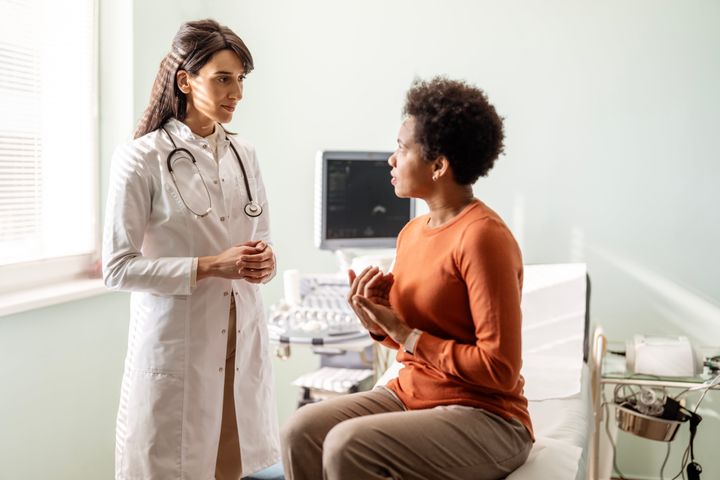Full-body MRIs, or magnetic resonance imaging, are having a moment. The scans, which take about an hour to conduct, take detailed pictures of the inside of your body with the intention of detecting all kinds of medical conditions, including cancer, neurological conditions like multiple sclerosis, liver diseases, and muscle or joint injuries.
As the New York Times recently reported, full-body MRIs have become somewhat of a status symbol. Celebrities like Kim Kardashian and Jenna Dewan have vouched for the scans on Instagram. And in May, Maria Menounos said a full-body scan revealed a 3.9-centimeter malignant mass on her pancreas ― an abnormality that wasn’t detected via traditional diagnostic tools, the journalist told “Today.”
Dr. Ilana Richman, an internal medicine physician with Yale Medicine, said full-body MRIs are appealing because they provide a clear snapshot of our organs. “Maybe you could find something early and treat it before it becomes a problem,” Richman told HuffPost.
But the scans aren’t accessible ― or even beneficial ― for many people. A scan at Prenuvo, a leading provider, will cost you roughly $2,500, for example. That’s entirely out of pocket, as they aren’t reimbursed by health insurance.
We also don’t have strong scientific data suggesting routine full-body MRIs improve the length or quality of people’s lives, Richman said. And there’s always the risk they could pick up an abnormality that may lead to unnecessary follow-up testing and health anxiety.
If you’re curious about your health but can’t afford a full-body MRI, there are cheaper, more accessible tests you can do instead. Here are a handful of them.
Annual Physical
The single most impactful step you can take is to get an annual health examination with a primary care physician. Doing so helps you establish a relationship with a doctor you trust in the event you develop a health problem in the future, said Dr. Bryant Lin, a primary care physician with Stanford Health Care.
The annual physical is a great time to evaluate your basic vitals, such as blood pressure, body temperature and pulse, along with your weight, height and respiratory function, said Dr. Kathy Nguyen, a family medicine physician with Memorial Hermann.
Your physician will also review your medical history and recent health concerns to determine if you may need to undergo additional testing. If, for example, you have a higher risk of heart disease or cancer, your physician can make recommendations for specific tests.
The physical is a great place to kick off your health care journey. “Annual exams allow the physician to individualize the screening for their patients,” Nguyen said.
Routine Cancer Screenings
We routinely screen for the most common cancers among adults: breast cancer, colorectal cancer, lung cancer, cervical cancer and prostate cancer. People often get full-body MRIs to screen for cancer, and these other screenings fill the same purpose, Lin said.
One of the most common screenings for women is a mammogram, which uses an X-ray of the breast to look for signs of breast cancer, largely for women over 40. Another is a pap test, a procedure to test for cervical cancer, every three years starting at age 21.
Men between the ages of 55 and 69 may choose to start prostate cancer screening. Prostate screenings, a type of blood test, can help reduce the risk of death from prostate cancer; however, these tests can pick up false positives and require additional testing or a biopsy.
People with a history of smoking can get a low-dose computed tomography scan, which screens for lung cancer. These scans are a “reasonable way of reducing mortality from lung cancer because you can detect nodules early,” Lin said.
All adults should be screened for colorectal cancer starting at age 45. It’s the key to preventing and finding it early, according to the Centers for Disease Control and Prevention. There are a few different ways to go about this, such as a colonoscopy, stool tests, flexible sigmoidoscopy and CT colonography.
The recommendations for these cancer screenings fluctuate based on your age, family history, underlying health issues and risk factors.
“Go to your doctor and make sure you get your updated age-appropriate screening and risk-appropriate screening,” Lin said.
ljubaphoto via Getty Images
Regular Bloodwork
A simple blood test can reveal a lot about your health, and most insurance providers cover them under preventative care. If the lab work reveals any irregularities, people often change their behavior ― they’ll exercise more or eat healthier ― to lower their risk for future disease, Lin added.
Around age 45, everyone should be screened for diabetes, according to the American Diabetes Association. Men who haven’t had their cholesterol checked should start at age 35, and women should start getting screened for cholesterol at age 45. Lin encourages all of his patients to get a cholesterol and sugar screening. “It does impact behavior and awareness of a healthy lifestyle,” he said.
Spot-Specific MRIs
Instead of getting a full-body MRI, consider a spot-specific MRI instead. Localized MRIs are more affordable, as they’re often covered by health insurance. Plus, they’re really all that’s needed to investigate what’s causing a specific set of symptoms, Richman said.
The scan will be taken in the location where you have pain, uncomfortable symptoms or a known injury. For example, if somebody has a knee injury and they’re worried about a ruptured ligament, a spot-specific MRI is a great test that will give you a really careful picture of a joint, Richman explained.
“We really try to target using it to what the person is reporting, what their symptoms are, what their physical exam is like and what their risk factors are,” Richman said.
Genetic Testing
A number of health conditions are inherited, from some types of cancer to sickle cell anemia or cystic fibrosis. For people with a strong family history of certain diseases, it may be worth undergoing genetic testing, which is typically done via a blood test or saliva sample, to see if they’re a carrier of a variant that increases their risk of disease.
If you’re concerned about your genetic risk of disease, talk to a primary care doctor. They can refer you to a genetic counselor who can look at your medical background and make specific recommendations for testing. Counselors can help you interpret the findings, which is a necessary part of the process, Richman said.
“It can have implications for your current health, your future health and your family — and it’s really important to be prepared for what that information means and what you do with it,” she said.
The recommendations for most tests are extremely personalized and largely influenced by your medical history and risk factors. For example, depending on your symptoms and family history, it may be worth having your kidney and liver function checked along with your thyroid or blood count.
“We really try to target the screening to people who are at high risk for whatever reason,” Richman said.
You don’t need to spend a few grand to get a snapshot of your health. Stay up to date with these routine screenings, and, when in doubt, talk to your doctor about any health concerns — there’s a lot we can do to catch and treat diseases before they become a problem.


